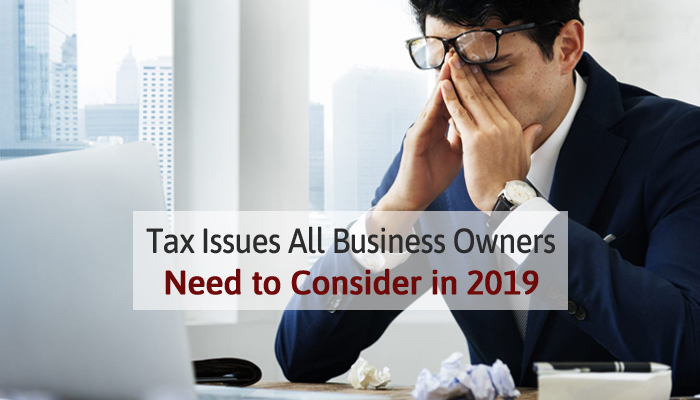Top Business Tax Challenges in 2018 and Effective Solutions To Them
Every tax season, business owners are worried about filing year-end returns. They must get an understanding of tax problems that could affect their enterprise. If not taken seriously, these tax problems can lead to penalties and costing a lot of money.
Significant Tax Challenges with Possible Solutions

With the passage of the tax cuts and jobs act law, a new flow-through tax regime was enacted. It is called a qualified business income (QBI).
The new law allows a deduction for noncorporate taxpayers for “qualified business income.” The deduction essentially applies to what you would typically think of as “pass-through” type entities — for example, partnerships and S-Corporations.
The interesting part of the “deduction” is that it only reduces taxable income, not adjusted gross income. So, the item as it is presented on your return for all intents and purposes is in its essence a rate reduction on pass-through income.
The general rules are as follows: The deduction is limited to 20% of a taxpayer’s QBI. QBI is defined in voluminous detail, and for purposes of this reply, I will spare you the details. However, it is important to note that some taxpayers in the service industry, professions such as attorneys and doctors are excluded above certain taxable income levels.
There are two important numbers to remember in QBI. Those are $157,500 and $315,000 for married taxpayers. Those are the income levels where the service businesses (SSTB) QBI starts to become limited. The limits are phased in as your income increases and eventually it is completely phased out at 207,500 and 415,000 for married taxpayers.
Taxpayers who do not operate under the SSTB rules will contend with the limitations that are phased-in for W-2 wages and property. A taxpayer has a choice of limiting the QBI by either 50% of wages or 25% of wages and 2.5% of qualified property. I’ll spare you with those definitions as well. The major complexity is not necessarily in the math of the deduction. Although the math is cumbersome, it is straight forward.
A business start-up has multiple entity choices. Even existing entities have a choice. A C corporation can change to S-corporation, Partnership, etc. Because of the nature of the way each individual entity is taxed, the results of the QBI deduction could vary greatly. For example, if a taxpayer is making $500,000 in a partnership with their spouse, their AGI is above the phase-in of wages and property. A partnership, by its very nature, can not pay wages to partners. So 50% of zero is zero, no QBI deduction. Now if they are an S corporation, they can pay themselves a wage and take advantage of the QBI deduction.
An interesting mathematical offshoot of the QBI is that if you look at the net income of the business and you multiply by 40%, you will know if you are limited by wages. So in our example, if your bottom line is 500k and your wages are over 200k (40%), you are not limited to the 50% wages. If it is under 200k, you are.
This is another layer of complexity that business owners will have to contend with in the future. Ideal compensation strategies are critical to QBI maximization. QBI is the most pervasive and challenging change in the code since 1986. If businesses can focus on only one aspect of the code, I’d suggest mastering 199A.
2. Impact on the Utility Industry
Riley Adams
A licensed CPA in the state of Louisiana working as a Senior Financial Analyst for Google in the San Francisco Bay Area. My personal finance blog: Young and the Invested

2018 brought about tax reform impacts, and many businesses needed to change course to navigate the new law successfully. One industry specifically impacted in a detrimental way was the utility industry.
Because of the way utility rates are set, companies bake the 35% federal income tax level into their rates. When the law changed the top rate to 21%, utility companies needed to file adjustments to their rate mechanisms to collect at this new rate. As a result, many utilities faced significant cash flow problems absent any action on their part. Many companies decided to issue equity to fund this shortfall in their cash flow forecasts and shore up their balance sheet and credit metrics.
Additionally, utilities accrue large Accumulated Deferred Income Tax balances (ADIT), and changes seen under tax reform caused unprotected amounts to be refunded as well. These two changes resulted in immediate benefits to customers, but significant business challenges to the utilities.
One further complication from tax reform comes from changes to bonus depreciation. This form of depreciation, which shields the taxes a company has to pay through instant deduction of a large amount of an investment’s value, lowered taxable income for utilities. After the loss of bonus depreciation, utilities will now have higher taxable income, all things being equal.

Choosing the right business structure is a top tax challenge every year. Businesses are continually evolving in size and how they make revenue, so you need to keep re-evaluating what makes sense for your business in its current stage of life.
Talking to your accountant and lawyer is the best way to figure out what makes sense for you in the new year.
4. Tax Filing for Individual States
Calloway Cook
Owner of an eCommerce business based in the U.S. – Illuminate Labs Inc.

The biggest tax challenge I face as the owner of an eCommerce business is staying on top of my tax filings for each individual state. Many business owners aren’t aware that due to a Supreme Court ruling in 2018, business owners have to track and file in every state that they have “economic nexus.” This is a threshold based on sales in each state and has nothing to do with a physical presence.
I use an accounting software called TaxJar for this purpose, and it’s greatly reduced my time filing and tracking state taxes.
5. Holding Company – A Better Option
Kane Georgiou
Entrepreneur, Ecommerce and affiliate marketing + consulting and property holdings. Owner of The Money Pig.

As we know, there are many taxes, and taxes are the number 1 expense for any person alive today.
I would split it into corporate tax, personal tax, and sales tax/vat.
I would discuss the option of a Holdings company as a vehicle for building wealth and being tax efficient.

The biggest 2018 tax challenge was the future impact of the Federal government tax cuts to corporations and small businesses, and especially to the sub-chapter S-corporations, LLCs & LLPs and like entities who by tax law serve as income tax pass-thru to individual shareholders and partners.
Further uncertainty was what individual states would do with respect to business taxation as this is a prime source of revenue for states and public municipalities. As such entities continue to seek new revenue especially to fund public pensions and services, they are more likely to do so from business entities arguing that with profits and income at record levels there is justification for higher taxes on those entities who do not vote per se as individual taxpayers do. In 2018, the result was either no change or increased state taxation with hew, if any, states reducing taxes.
For import-export businesses, there is the challenge of tariffs as set by the US and foreign governments. These tariffs are in effect taxes on products and have a significant impact on costs and profits, i.e., the higher the tariff, the more expensive the product. 2018 saw the beginning of “tariff wars.”
To most effectively address the above challenges in 2019, business entities would be wise to make projections as to income and profitability and inject the tax implications thereon. Those projections should enable businesses to develop a format fro which to make investments in plant and equipment which can be expensed or depreciated depending on the type of expense, the necessity to add employees, or in the case of the larger C-corporations to pursue share buybacks from cash hoards or reserve funds. These actions can have significant tax implications not just to the entities but also to shareholders and partners due to tax pass-thru regulations.
In addressing increased import-export tariffs, businesses are somewhat limited in what they can do as these “taxes” are government dictates with minimal or no input from businesses. Market forces will take effect, and businesses must assess the potential impact on the profitability of these taxes and their direct effect on the cost of goods bought and sold.
In summary, taxes are a cost of doing business variable with businesses having to be up to date on tax laws and with being sufficiently astute to adjust to the ever-changing and challenging business tax environment. By knowing the tax implications and, as best as possible predicting income, businesses can have a better grasp of the goal of maximizing profitability.
7. Recruiting and Retention Challenges
John Boyd
Principal of the Boyd Company in Princeton, NJ. My firm provides management counsel to major corporations. We are a top authority on how tax policy affects business location decisions and HR functions.

The 2017 Tax Reform Bill: While making the US more competitive globally and helping boost the US economy overall – has created recruiting and retention challenges in high tax states like NJ, CT, IL, and NY. The Tax Reform Act’s $10,000 property tax deduction is making it more difficult to recruit and retain highly paid executives and has been a major driver for high net worth individuals and executives to lower-taxed states like Florida.
It is not uncommon for property tax bills in the corporate clusters like Mercer County, NJ, Westchester, NY, Nassau County, NY to exceed $20,000 annually. When you factor in state income tax rates (NJ, CT, and NY are among the highest in the nation) – no wonder thousands of executives and high net worth people are migrating each year to Florida and the Carolina’s.
To deal with this, more and more of our clients are rapidly embracing the remote workforce option to allow key talent to work from wherever they wish to do so.

The newest tax challenge for many businesses was the Supreme court’s decision in Wayfair vs. South Dakota (June 21, 2018) allows states to require a remote seller with “economic and virtual contacts” in the state (economic nexus) to collect and remit sales tax, even if it has no physical presence in the state.
Now, there are about 25 states that are enacting similar laws, and this decision could impact every business that sells its products and services out of state. Small companies now need to have a common sense manageable plan for compliance in their home state and a compliance plan in states they do business in remotely.
A multistate uniform exemption certificate completed by customers is a solution for many businesses, and a close review of out of state business relationships for sales tax compliance and volume levels for information reporting is an additional action item.

Probably the biggest challenge preparing 2018 returns was the application of the IRC Sec. 199A passthrough deduction of 20% for trades and businesses. The problem was exacerbated by a general lack of guidance from the IRS — especially in terms of what constitutes a “trade” or “business.”
The trade or business definition has long plagued all sorts of tax decisions for years, and tax code does not provide a definitive “bright line” definition of a trade or business. The IRC Sec 199A regulations simply adopted an existing subjective definition that relies on the outcomes of past court cases and interpretive rules the IRS has issued under IRC Sec. 162, which is the most familiar provision using the term “trade or business.” This left much room for interpretation; most notably whether or not rental real estate income qualifies for the IRC Sec. 199A deduction.
To add to the confusion, the IRS issued Notice 2019-07 providing safe harbor qualifications for rentals which led taxpayers and practitioners to believe rentals were required to meet the safe harbor to qualify which is simply not true. Failure of the taxpayer to satisfy the requirements of the safe harbor does not preclude a taxpayer from otherwise establishing that a “rental real estate enterprise” is a trade or business for purposes of IRC Sec. 199A.
In fact, if one takes the time to review the myriad of tax court cases on the issue, they will find in virtually all cases rentals were ruled to be a trade or business.
Conclusion
Tax is a critical topic for the business owners, and hence, should be handled accordingly. Changes in the tax rules should always be taken into consideration, and a thorough understanding of the same is required.









